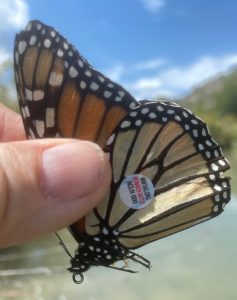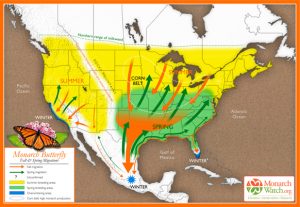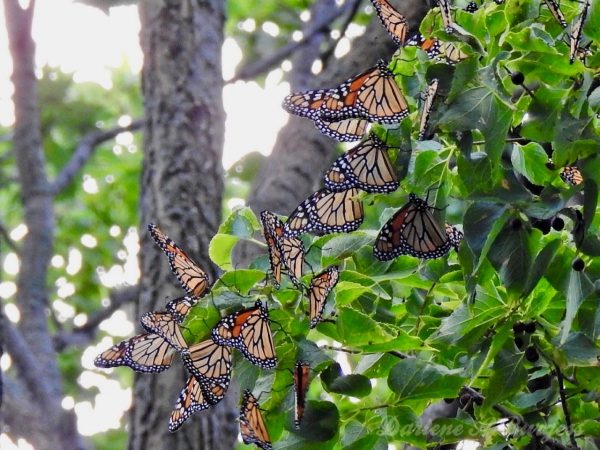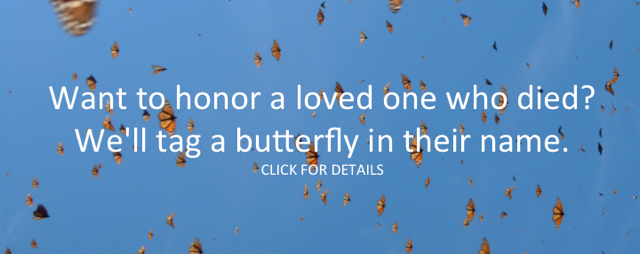SAN ANTONIO — In this year unlike any other, the 2020 monarch butterfly migration has begun. Masses of the iconic insects are moving south from Canada and the northern U.S. in keeping with the reassuring rhythms of the planet.
Small numbers were spotted last weekend in San Antonio and along the Llano River. Sightings should increase over the coming weeks, with peak migration for our latitude slated for October 10 – 22, just in time for the fifth annual Monarch Butterfly and Pollinator Festival, which occurs online this year.
How does this year’s monarch population measure up?
Scientists and monarch watchers hesitate to make predictions, since so many variables factor into the migration’s success: wildfires, hurricanes, cold snaps, heat waves, and human interference like this recent example of aerial pesticide spraying in Fargo, North Dakota which resulted in a “monarch massacre.”

First butterfly of the fall migration season was tagged in memory of Doris Wallace of San Antonio. Photo by Monika Maeckle
Chip Taylor, founder of Monarch Watch, the citizen science tagging organization based at the University of Kansas at Lawrence, sent a “tagger alert” out to those north of Oklahoma City earlier this week.
“This will be a fast paced migration compared to recent years. If you hesitate, you could miss the opportunity to tag,” Taylor said on the DPLEX, an email list of monarch butterfly enthusiasts that reaches about 800 scientists, citizen scientists and hobbyists.
Taylor speculated that given recent weather patterns, a short window exists in the northern zones for monarchs to move south. They prefer to migrate with temperatures in the 60s and 70s, he wrote.
“Once this cold surge passes after Friday and Saturday, monarchs will be on the move,” Taylor wrote. “The population will advance at a steady pace into the South region and it is likely that this migration will be more compressed with few stragglers.”
Thousands of citizen scientists tag monarchs each fall. They capture migrating butterflies in nets, adhere a tiny sticker to the discal cell of their forewing, record the butterfly’s sex, the date, time and place of the tagging, and report the data to Monarch Watch.
We tagged our first monarch of the season in honor of Doris Wallace, the first person in San Antonio to die of COVID-19. The 83-year-old dressmaker and loving grandmother died on March 21, 2020. Read more about our Monarch Butterfly and Pollinator Festival and the monarch memorial initiative to tag butterflies in memory of those who died because of COVID-19, social injustice or other causes.
From Enid, Oklahoma, Diane Levesque shared a photo on the DPLEX of monarch butterflies “flirting” and mating on September 8.
For those unaware, monarchs either migrate or mate. They don’t have the energy to do both. The butterflies that spend their winters in the Mexican mountains experience what’s called reproductive diapause–that is, they postpone all reproductive activities until spring.
That’s when the multi-generation migration begins, as monarchs move north in search of milkweed on which to lay their eggs. The cycle continues throughout the summer as the first generation gives way to the second, until the fall when fourth and fifth generation monarchs get cues from the sun that alert them to start heading south.
“I expect a significant change in attitude regarding migration when it warms up again,” Levesque said in her email. “Because it was only just this morning when everybody thought this (monarch) waystation was the perfect place to hook up and make merry…and babies.”
Summer breeding in the Midwest and recent reports from Canada and northern states reflect decent numbers of the charismatic insects.
Monarch watcher Darlene Burgess in Ontario, Canada, reported a roost of 1,750 on September 8 at Point Pelee National Park, Canada’s most southern mainland point that sits on Lake Erie’s north shore. See photo at the top of this post.

Citizen science organization Journey North, which tracks the monarch migration and others, reported sightings of more than 18 monarch butterfly roosts as of September 4. During the migration, monarchs typically nectar on flowers in the morning, fly during the day, especially when there’s a southbound wind, then drop from the sky in the evening to roost in groups overnight. Check out Journey North’s live migration maps here.
Here in the Texas Funnel, the migratory corridor through which migrating monarchs must pass on their way to Mexico, widespread drought has been interrupted recently with consecutive days of rain. The Texas Funnel is critical to the migrating insects in the later stages of their migration since here is where they fuel up and build the fat stores that will get them through the winter in Mexico. A lack of nectar sources can be devastating.
A visit to the Llano River in the Texas Hill Country this week showed evidence of an early pulse of monarchs known as the “pre-migration migration.” The early arrivals typically show up for Labor Day.
Eggs and caterpillars graced the leaves of abundant Swamp milkweed, Asclepias incarnata. Its pink umbels also drew bees and other butterflies. Late flowering boneset and goldenrod also showed their blossoms and the Frostweed waited its turn to flower in the coming weeks.
Late season nectar was readily available on the Llano River, as one female dropped eggs on Swamp milkweed and a stout male nectared on its blooms.
But the story was different 30 miles away in Menard, according to Jenny Singleton, a longtime docent for the Grapevine Flutterby Butterfly Festival who’s been tagging monarchs for decades at her family’s ranch along the San Saba River.
“We have nothing blooming,” said Singleton via text. “No nectar sources at all….In fact, the bees have been covering my hummingbird feeders, so I’ve started filling plant saucers with sugar water.”
In Comfort, just outside San Antonio, Cathy Downs, an outreach specialist for Monarch Watch, reported no sightings of monarchs or larvae. “I haven’t seen either since the end of May,” she said. Yet along the San Antonio River and in some San Antonio gardens, Tropical milkweed plants hosted tiny monarch caterpillars and eggs.
“Folks need to move beyond the close tracking of each year’s crop, or migration,” said migration studies expert Andy Davis, Assistant Research Scientist at the University of Georgia’s Odum School of Ecology and editor of the journal, Animal Migration, via email. Davis added that insect populations naturally fluctuate, experiencing ups and downs through time.
“I try to emphasize that having a down year is not a bad thing,” he said. “In those years, the remaining monarchs get to enjoy having all of the resources to themselves, with less competition….So I guess in my book, I’m not worried whether this is a big migration or not. Either way, the monarchs will be fine.”
High temperatures in Texas may set a challenging stage for the migration, but continuing rains will likely have a softening effect. Cooler, wetter weather will allow budding flowers to maintain their blooms longer, to feed the migrants and increase their fat stores for a successful overwintering in Mexico.
TOP PHOTO, Pelee Point monarch sanctuary on September 8, 2020. Photo by Darlene Burgess
Related Articles
- Lost a loved one to COVID-19, social injustice or other causes? We’ll tag a butterfly in their name
- Monarch Butterfly and Pollinator Festival to remember those lost in 2020
- Three monarch butterflies tagged at 2018 Festival recovered in Mexico
- Thousands gather at Pearl to close out fourth annual Monarch Butterfly and Pollinator Festival
- Waggle Dance Anyone? Learn how at Monarch Butterfly and Pollinator Festival
- Five years later, monarch butterfly champion status delivers
Like what you’re reading? Don’t miss a single article from the Texas Butterfly Ranch. Sign up for email delivery at the bottom of this page, like us on Facebook, follow us on Twitter, @monikam or on Instagram.



“I try to emphasize that having a down year is not a bad thing,” he said. “In those years, the remaining monarchs get to enjoy having all of the resources to themselves, with less competition….So I guess in my book, I’m not worried whether this is a big migration or not. Either way, the monarchs will be fine.” It’s great to see Andy is finally coming around. Now if he would just start supporting citizen scientists raising a hundred or so wild ones a season for local release like our friend Lincoln Brower did. Our group has over 6000 enthusiasts planting and rearing adding 1500 new members this year. Raises awareness. Nothing to worry about. Right Andy ? https://www.facebook.com/groups/HowtoRaiseMonarchButterflies/
[…] Habitat loss and an increase of extreme weather also play a major roll in the reduction of these iconic butterflies. You can help these lovely creatures by planting native plants that flower in April and October. […]